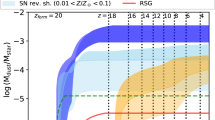Abstract
The conditions required for the expulsion of dust grains from primordial galaxies (dark-matter halos) are considered. The initial configuration is taken to be a dark-matter halo with the profile of a modified isothermal sphere; the baryons are taken to be in equilibrium with the corresponding virial temperature. The baryon density profile is calculated assuming hydrostatic equilibrium. A star-formation rate corresponding to a star-forming efficiency of 10% is assumed. The dust is transported from the galaxy by the radiation of stars concentrated in the central regions. Due to friction via collisions with gas in central regions, a fairly high luminosity is required in order for the radiation pressure to be strong enough to expel dust from the galaxy—the ratio of the luminosity to the total mass of the galaxy can reach unity.
Similar content being viewed by others
References
T. Abel, P. Anninos, Y. Zhang, and M. L. Norman, New Astron. 2, 181 (1997).
V. Bromm, P. Coppi, and R. Larson, Astrophys. J. 564, 23 (2002).
A. Songaila, Astrophys. J. Lett. 561, L153 (2001).
P. Madau, A. Ferrara, and M. J. Rees, Astrophys. J. 555, 92 (2001).
A. Aguirre, J. Schaye, and T. Theuns, Astrophys. J. 576, 1 (2002).
S. Bianchi and A. Ferrara, Mon. Not. R. Astron. Soc. 358, 379 (2005).
A. Venkatesan, B. B. Nath, and J. M. Shull, Astrophys. J. 649, 31 (2006).
B. M. Shustov, D. S. Wiebe, and A. V. Tutukov, Astron. Astrophys. 317, 397 (1997).
Yu. A. Shchekinov, Astron. Astrophys. Trans. 21, 131 (2002).
J. Binney and S. Tremaine, Galactic Dynamics (Princeton Univ. Press, Princeton, 1987).
A. Burkert, Astrophys. J. 447, 25 (1995).
A. Fujita, C. L. Martin, M. M. MacLow, and T. Abel, Astrophys. J. 599, 50 (2003).
R. Barkana and A. Loeb, Phys. Rep. 349, 125 (2001).
B. T. Draine and E. E. Salpeter, Astrophys. J. 231, 77 (1979).
H. Yan, A. Lazarian, and B. T. Draine, Astrophys. J. 616, 895 (2004).
A. M. Hopkins and J. F. Beacom, Astrophys. J. 651, 142 (2006).
Author information
Authors and Affiliations
Corresponding author
Additional information
Original Russian Text © E.O. Vasiliev, Yu.A. Shchekinov, 2014, published in Astronomicheskii Zhurnal, 2014, Vol. 91, No. 8, pp. 583–591.
Rights and permissions
About this article
Cite this article
Vasiliev, E.O., Shchekinov, Y.A. Expulsion of dust from dark-matter halos at high redshifts. Astron. Rep. 58, 497–505 (2014). https://doi.org/10.1134/S1063772914080071
Received:
Accepted:
Published:
Issue Date:
DOI: https://doi.org/10.1134/S1063772914080071



